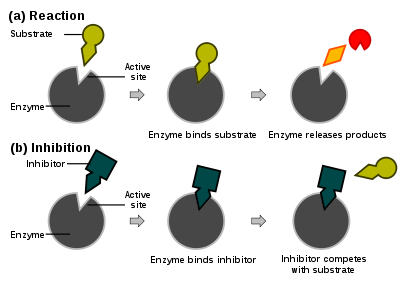Enzyme Inhibition
An enzyme inhibitor is a molecule that decreases their activity and binds to enzymes. Therefore blocking an enzyme's activity can correct a metabolic imbalance or kill a pathogen, several drugs are enzyme inhibitors. They are also used as pesticides and herbicides. Not all molecules which bind to enzymes are inhibitors enzyme activators bind to enzymes and raise their enzymatic activity, although enzyme substrates bind and are converted to products in the normal catalytic cycle of the enzyme. The catalytic rate of an enzyme can be lowered through inhibitor molecules. Several inhibitors exist, involving normal body metabolites foreign toxins and drugs. Reversible inhibition can be separated into noncompetitive and competitive.

The binding of an inhibitor can end a substrate from entering the enzyme's active site and hinder the enzyme from catalyzing its reaction. Inhibitor binding is either irreversible or reversible. Irreversible inhibitors commonly react with the enzyme and modify it chemically for instance through covalent bond formation. These inhibitors change key amino acid residues required for enzymatic activity. In compare, reversible inhibitors bind non-covalently and various kind of inhibition are produced depending on whether the enzyme-substrate complex, these inhibitors bind to the enzyme or may be both.
Enzyme inhibition
Several kinds of molecule exist that are capable of interfering with the activity of an individual enzyme. Any molecule that acts straightly on an enzyme to lower its catalytic rate is known an inhibitor. Several enzyme inhibitors are normal body metabolites which inhibit a particular enzyme as part of the normal metabolic control of a way. Another inhibitors may be foreign substances, like as drugs or toxins where the effect of enzyme inhibition could be either therapeutic or at the other extreme and lethal. Enzyme inhibition may be of two major kinds: reversible or irreversible, with reversible inhibition itself being divided into competitive and noncompetitive inhibition. Reversible inhibition can be overcome through erasing the inhibitor from the enzyme, for instance through dialysis, but this is impossible for irreversible inhibition, through definition.